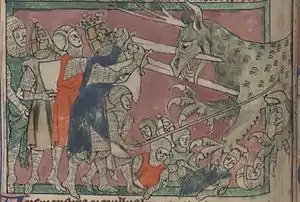Odontotyrannos
Odontotyrannos (Greek: όδοντοτύραννος), also odontotyrannus or dentityrannus[lower-alpha 1] ("tooth-tyrant") is a mythical three-horned beast said to have attacked Alexander the Great and his men at their camp in India, according to the apocryphal Letter from Alexander to Aristotle and other medieval romantic retellings of Alexandrian legend.[2]

Bibliothèque nationale fr. 24364[1]
Descriptions
According to the Latin Letter from Alexander, the creature had a black, horse-like head with three horns protruding from its forehead, and exceeded the size of an elephant. It was undeterred by the sight of fire, killing twenty-six[lower-alpha 2] Macedonians and incapacitating fifty-two before being put down by thrusts from hunting spears. The local Indians reportedly called the beast "tooth-tyrant"[3] (dentityrranus or odontatyrannus).[lower-alpha 3][6]
Valerius' biography of Alexander[lower-alpha 4], dated to the beginning of the 4th century, spells the beast's name as "odontotyrannus" and states that the strength of 300 men was required to drag its body out of the river.[lower-alpha 5][7][5] In the Syriac version of Pseudo-Callisthenes, it is the Mashḳělath or Mashklet (Syriac: ܡܫܩܠܬ[8][9]) which causes 26 casualties among the Macedons and requires 300 men to tug out of a ditch,[10] and in the Armenian version 1,300 were needed for the job.[lower-alpha 6][11][12]
In the Ethiopic version, it is an elephant-sized beast with tusks that attacks; this creature is unnamed but corresponds to the odontotyrannus. When it is eviscerated, the Macedonians discover among its stomach contents scorpions as well as large fish the size of an ox.[13] In the 5th-century Greek writings of Palladius[lower-alpha 7] and the 9th-century writings of George Hamartolos, the odontotyrannus (όδοντοτύραννος) is an amphibious carnivore that can devour an elephant.[14]
In Li romans d'Alixandre of Alexandre de Bernay, the beast is named tirant,[9] and in Thomas de Kent's Roman de toute chevalerie, the Old French name is dent-tyrant.[1] In the Middle English King Alisaunder, the name is given as "deutyrauns".[lower-alpha 8][9][15]
Zoological identifications
Many scholars have identified various large beasts in the animal kingdom as to its identity. Budge suggested it may be a crocodilian native to the Ganges, and hinted the Syriac name might be a corruption of the makara, a composite creature in Hindu mythology.[10] It may also be based on Ctesias's description of the giant fanged Indus worm.[16] The makara theory and Ctesia's influence is also supported by Gunderson.[17][12] Others proposed a rhinoceros, though conceded it may just be an imaginary creature.[18]
Reconstructed Sanskrit name
Christian Lassen in the 19th century reconstructed the original name of this beast to be *dantešvara "lord of teeth", from danta "tooth" and īšvara "the Lord".[19] This unattested form was rejected by Roger Goossens,[20] who proposed instead dvijarāja which carries the dual meaning of "king of reptiles" or "king of teeth".[21][22]
Explanatory notes
- Also dentes tirannus, dentestyrannus
- Or thirty-six, in some variants of the legend.
- Some manuscripts and Kübler's edition read "odontatyrannum" with an "a".[4][5]
- Res gestae Alexandri Macedonis.
- Latin text reads:".. vix trecentorum hominum manus nisu extractus de flumine"
- In the Armenian, the beast is called a "unicorn" or "one horned beast" (Wolohojian tr.)
- On the Life of the Brahmans; one abridged recension is referred to as "Commonitorium Palladii de Bragmanis" (Stoneman 2012, pp. xxv, 113n).
- Skeat 1886, p. 309n's "deutyrans" appears to be a typographical error.
References
- Citations
- Cary, George (1956). The Medieval Alexander. University of Cambridge Press. pp. 35–36.
- Harf-Lancner, Laurence (2012), Maddox, Donald; Sturm-Maddox, Sara (eds.), "From Alexander to Marco Polo, from Text to Image: The Marvels of India", Medieval French Alexander, SUNY Press, p. 237, ISBN 9780791488324
- Stoneman (2012), p. 9.
- Rypins (1924), p. 88 n2.
- Gunderson, Lloyd L. (1980), Alexander's letter to Aristotle about India, Hain, p. 54, ISBN 9783445019929
- Orchard (2003), pp. 126–7.
- Skeat (1886), pp. 221, 309n.
- Budge 1896, p. 150, n1
- Perkins, Justin; Woolsey, Theodore D. (1854), "Notice of a Life of Alexander the Great", Journal of the American Oriental Society, 4: 379n, JSTOR 592285
- Budge (1889), pp. 98.
- Wolohojian, Albert M. (1969), The Romance of Alexander the Great by Pseudo-Callisthenes (from the Armenian), Columbia University Press, pp. 126–7
- Pritchard, Roger Telfryn (1992), The History of Alexander's Battles: Historia de Preliis, the J1 Version, PIMS, p. 157, ISBN 9780888442840
- Budge (1896), pp. 149–150.
- Stoneman (2012), pp. 38, 31–32.
- Weber, Henry William, ed. (1810), Kyng Alisaunder, George Ramsay, v. 5416 (p. 223)
- Stoneman (2012), p. xxiii.
- Gunderson (1980), pp. 103ff.
- Dr Kees Rookmaaker. "Source Book of the Rhinoceros" (PDF). Rhino Resource Center. Retrieved 2015-09-13.
- Lassen (1858), p. 375
- Goossens (1929).
- Seldeslachts, Erik (1998), "Translated Loans and Loan Translations as Evidence of Graeco-Indian Bilingualism in Antiquity", L'Antiquité classique: Revue semestrielle, 67: 286
- Jalabert, Louis (1930), "Bulletin du Byzantinisme", Recherches de Science Religieuse, 20: 468–469
- Bibliography
- Budge, E. A. Wallis, ed. (1889). The History of Alexander the Great, Being the Syriac Version. The University Press. pp. lxxiii, 98 and n1. ISBN 9781107631175.
- Budge, E. A. Wallis, ed. (1896). The Life and Exploits of Alexander the Great, being a series of translation of the Ethiopic histories. Clay. pp. 149–150.
- Goossens, Roger (1929), "L'όδοντοτύραννος, animal de l'Inde", Byzantion, IV (1927–1928): 29–52
- Orchard, Andy (tr.), ed. (2003). Letter of Alexander to Aristotle. ISBN 9780802085832.
{{cite book}}:|work=ignored (help) - Rypins, Stanley, ed. (1924). Letter of Alexander the Great to Aristotle. pp. 22, 88 and n2, 86 n10.
{{cite book}}:|work=ignored (help) - Skeat, Walter William, ed. (1886). The Wars of Alexander: An Alliterative Romance. Early English Text Society. N. Trübner. p. 309.
- Stoneman, Richard (tr.), ed. (2012), The Legends of Alexander the Great, I.B.Tauris, ISBN 978-1848857858